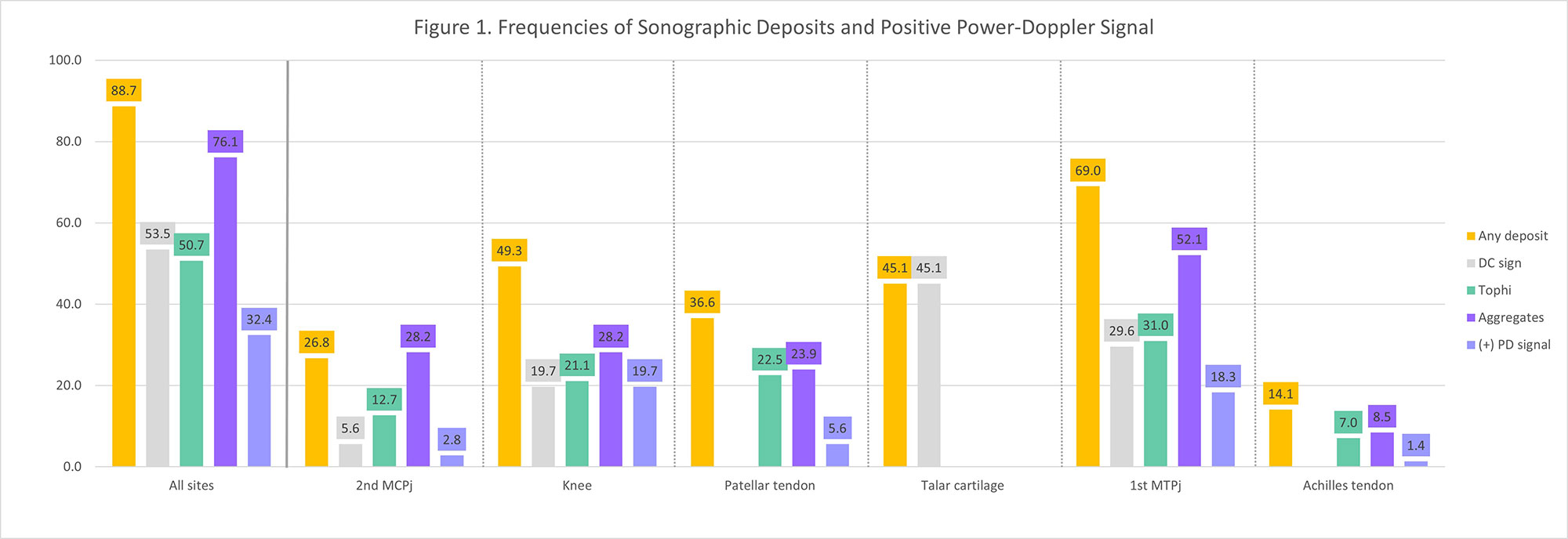Session Information
Date: Sunday, November 13, 2022
Title: Abstracts: Metabolic and Crystal Arthropathies – Basic and Clinical Science
Session Type: Abstract Session
Session Time: 3:00PM-4:30PM
Background/Purpose: The applicability of the preliminary remission criteria for gout [PMID 26414176] in clinical practice is unknown. This study evaluates the sonographic prevalence of monosodium urate (MSU) deposition and associated inflammation in patients with gout in remission.
Methods: Observational cross-sectional multicenter study. Patients with gout (ACR/EULAR classification criteria +/- MSU crystal-proven) who met preliminary remission criteria were consecutively recruited at eleven Spanish rheumatology units. We determined the prevalence (with 95% confidence interval -CI) of sonographic signs of MSU crystal deposits (tophi, aggregates and double contour sign) and inflammation by power Doppler [PD] signal (graded as 0-3, positive if ≥1). We followed a sonographic assessment that scanned bilaterally 1st metatarsophalangeal and 2nd metacarpophalangeal joints, knees, talar cartilages and patellar and Achilles tendons. Associations between deposits and PD signal and clinical and laboratory variables were also analyzed.
Results: We report our initial 71 participants, mean aged 66 years (SD 9.8) and 93.0% males. Mean gout duration was 14.7 years (SD 12.2), the disease was tophaceous at baseline in 15.5%, and mean serum urate (SU) level in the preceding year was 4.7 mg/dl (SD 0.8). MSU deposits were detected in at least one scanned site in 88.7% of participants (95%CI 79.3-94.2%), with a median of 3 locations with deposits (range 0-9). Articular deposits (81.7%) were more common than tendinous deposits (45.1%), and aggregates were the most frequent sonographic finding (76.1%) [Figure 1]. A positive PD signal was present in 32.4% of participants (95%CI 22.7-44.0%), mainly at joints (29.6%). Prevalent deposits and positive PD signal were found associated both at joints (p=0.049) and tendons (p=0.015). Regarding secondary variables, sonographic deposits were associated with higher maximal SU levels registered at lab records (9.2 mg/dl, IQR 8.2-10.0 versus 7.9 mg/dL, IQR 7.8-8.7, p=0.030). Participants with positive PD signal showed higher SU urate levels in the preceding year (5.1 mg/dl, IQR 4.7-5.4, versus 4.8 mg/dl, IQR 4.1-5.2, p=0.057). No other associations were found.
Conclusion: Most patients with gout fulfilling remission criteria have sonographic MSU crystal deposits, and one third also show subclinical sonographic inflammation. These data suggest that achieving remission criteria should not be taken as the disease cure in gout management.
To cite this abstract in AMA style:
Domínguez-Lirón N, De Miguel E, Martínez-Sanchis A, Peiteado D, Garcia-Magallon B, Vicente-Rabaneda E, Calvo E, Rodríguez B, Prada A, Blanco Cáceres B, Bernal J, Sivera F, Castañeda S, Mínguez S, Barrio L, Vázquez-Díaz M, Senabre J, Bohorquez C, Andrès M. Presence of Sonographic Crystal Deposits and Power-Doppler Signal in Patients with Gout Fulfilling Remission Criteria: A Multicenter Study [abstract]. Arthritis Rheumatol. 2022; 74 (suppl 9). https://acrabstracts.org/abstract/presence-of-sonographic-crystal-deposits-and-power-doppler-signal-in-patients-with-gout-fulfilling-remission-criteria-a-multicenter-study/. Accessed .« Back to ACR Convergence 2022
ACR Meeting Abstracts - https://acrabstracts.org/abstract/presence-of-sonographic-crystal-deposits-and-power-doppler-signal-in-patients-with-gout-fulfilling-remission-criteria-a-multicenter-study/

